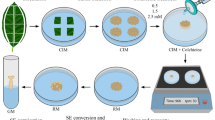Abstract
The chromosome behaviour has been compared in three Crepis capillaris callus culture lines and the roots regenerated from these calli. The calli were obtained from explants derived from plants without and with two B chromosomes and the hairy roots were obtained from plants transformed with Agrobacterium rhizogenes. Cytological studies demonstrated that the presence of additional DNA as B chromosomes or as T-DNA had an influence on the numerical and structural variability of the standard chromosome in long-term callus cultures and in regenerated organs. The callus with two B chromosomes displayed higher levels of polyploidyzation than callus without B chromosomes. The roots regenerated from both these calli were only diploid, while roots regenerated from transformed callus were also polyploid.
Similar content being viewed by others
References
Ambros PF, Matzke MA & Matzke JM (1986) Detection of 17 kb unique sequence (T-DNA) in plant chromosomes by in situ hybridization. Chromosoma 94: 11–18
Ashmore SE & Gould AR (1981) Karyotype evolution in a tumour derived plant tissue culture analysed by Giemsa C-banding. Protoplasma 106: 297–308
Bataglia E (1964) Cytogenetics of B-chromosomes. Caryologia 17: 245–299
Bayliss MW (1975) The effects of growth in vitro on chromosome complement of Daucus carota (L.) suspension cultures. Chromosoma 51: 401–411
Brossard D (1978) Microspectrophotometric and ultrastructural analyses of a case of cell differentiation without endopolyploidsation: the pith of Crepis capillaris (L.) Waller. Protoplasma 93: 369–380
Butcher DN, Sogeke AK & Tommerup IC (1975) Factors influencing changes in ploidy and nuclear DNA levels in cells from normal, crown-gall and habituated cultures of Helianthus annus L. Protoplasma 86: 295–308
D'Amato F (1985) Cytogenetics of plant cell and tissue cultures and their regenerates. CRC. Crit. Rev. Plant. Sci. 3: 73–112
Fenzl E & Tschermak-Woess E (1954) Untersuchungen zur karyologischen Anatomie der Achse der Angiospermen. Osterr. bot. Z. 101: 140–164
Jones RN & Rees H (1982) B Chromosomes. Academic Press, London
Karp A (1989) Can genetic instability be controlled in plant tissue cultures? Newsletter. IAPTC 58: 2–11
Kodama A & Mitchell JP (1982) Relative DNA content of individual chromosomes, karyotype and ploidy in crown gall tumor cell of Crepis capillaris. Jpn. J. Genet. 57: 163–169
Lee M & Phillips RL (1988) The chromosomal basis of somaclonal variation. Annu. Rev. Plant. Physiol. Plant. Mol. Biol. 39: 413–437
Maluszynska J (1990) B chromosomes of Crepis capillaris (L.) Waller. in vivo and in vitro. Prace Naukowe Uniwersytetu Slaskiego Nr. 1147, Katowice
Murashige T & Skoog F (1962) A revised medium for rapid growth and bioassays with tobacco tissue cultures. Physiol. Plant. 15:473–497
Navashin M(1925) Morphologishe Kernestudien der Crepis-Arten in Bezug auf die Artbildung. Z. Zellforsch. 2: 98–110
Peschke WM & Phillips RL (1992) Genetics implications of somaclonal variation in plants. Advances in Genetics 30: 41–75
Reinert J & Kuster HJ (1966) Diploide, chlorophyllhaltige Gewebekulturen aus Blattern von Crepis capillaris (L.) Waller. Z. Pflanzenphysiol. 54: 213–222
Rutishauser A & Rothlisberger E (1966) Boosting mechanism of B-chromosomes in Crepis capillaris. Chromosomes Today 1: 28–30
Sacristan MD (1971) Karyotypic changes in callus cultures from haploid and diploid plants of Crepis capillaris (L.)Waller. Chromosoma 33: 273–293
Sacristan MD & Wendt-Gallitelli MF (1971) Transformation to auxin-autotrophy and its reversibility in a mutant line of Crepis capillaris callus culture. Mol. Gen. Genet. 110: 355–360
Sacristan MD & Wendt-Gallitelli MF (1973) Tumorous cultures ofCrepis capillaris: chromosomes and growth. Chromosoma 43: 279–288
Sheridan WF (1975) Plant regeneration and chromosome stability in tissue cultures. In: Ledoux L (ed) Genetic Manipulation with Plant Material (pp 263–267). Plenum Publishing, New York
van den Bulk RW, Loffler HJM, Lindhout WH & Koornneef M (1990) Somaclonal variation in tomato: Effect of explant source and comparison with chemical mutagenesis. Theor. Appl. Genet. 80: 817–825
Vapper M & Kallak H(1986) Karyotypic differentiation of long-term callus culture of Crepis capillaris. Biol. Plant. 28: 417 423
Yazawa S (1967) Cytological and morphological observation on the callus tissue of Crepis capillaris. Bot. Mag. Tokyo. 80: 413–420
Author information
Authors and Affiliations
Rights and permissions
About this article
Cite this article
Maluszynska, J. The effect of B chromosomes and T-DNA on chromosomal variation in callus cells and regenerated roots of Crepis capillaris. Plant Cell, Tissue and Organ Culture 50, 113–118 (1997). https://doi.org/10.1023/A:1005727529303
Issue Date:
DOI: https://doi.org/10.1023/A:1005727529303




